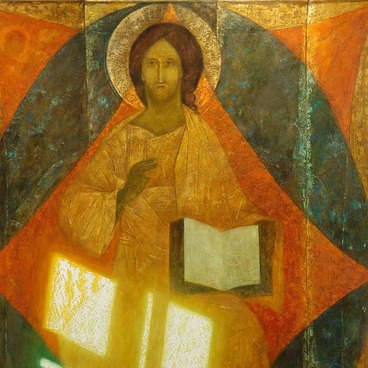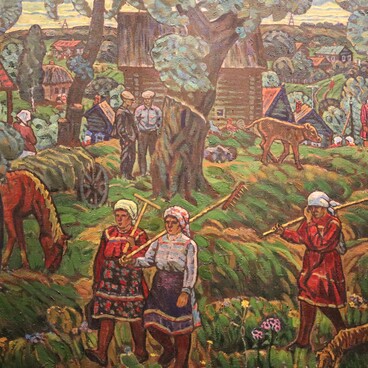In the painting “Mordovian Embroideresses. Dowry”, Igor Sidelnikov, an Honored Artist of the Russian Federation, celebrates the richness and beauty of national traditions. Igor Ivanovich Sidelnikov (1937–2020) was a People’s Artist of the Republic of Mordovia. He went through all the stages of professional training in art: he graduated from the Konstantin Savitsky Art School in Penza, the Surikov Moscow State Art Institute, and trained in the studio of Gely Korzhev at the Academy of Arts of the USSR. The artist had many opportunities in the capital, but he returned to Ruzayevka, a town in the Republic of Mordovia, to enrich the cultural life of his small homeland.
The canvas “Mordovian Embroideresses. Dowry” is one of the most significant works on a national motif. The pictorial image was inspired by the tradition of preparing a dowry for a wedding.
The Mordovian wedding was distinguished by original traditions and rituals, theatrical actions and colorful outfits. According to custom, the bride prepared her dowry, as well as wedding offerings from a young age. If there were not enough gifts, neither the girl herself nor her parents could agree to the wedding, as it concerned the family’s honor. The gifts were always prepared by hand. The bride’s girlfriends would help in the preparation of the dowry. On the evening before the wedding, the young woman’s mother treated them to dinner, and the bride herself thanked them for their help and presented each of them with a silk ribbon.
Although the plot of canvas is based on the tradition of preparing a dowry for a wedding, its main idea is greater than the storyline: the artist primarily seeks to exhibit the value of national traditions.
Three young women in Moksha costumes working on the gifts are depicted against the background of a white canvas with Erzya embroidery. The strictly balanced composition, the measured gestures, the conviviality of red and white colors, and the prideful faces — all this makes the image appear monumental. The heroines in the central part of the canvas are depicted from a low angle, which emphasizes their majestic appearance.
Igor Sidelnikov opts for a dominant color palette based on a combination of red and white colors, characteristic of the Mordovian costume. His Moksha women are peculiar monuments to the national traditions. The artist seems to stop the time so that the viewer can admire the dignity and magnificent calmness of the heroines, and the beauty of their creations.
The canvas “Mordovian Embroideresses. Dowry” is one of the most significant works on a national motif. The pictorial image was inspired by the tradition of preparing a dowry for a wedding.
The Mordovian wedding was distinguished by original traditions and rituals, theatrical actions and colorful outfits. According to custom, the bride prepared her dowry, as well as wedding offerings from a young age. If there were not enough gifts, neither the girl herself nor her parents could agree to the wedding, as it concerned the family’s honor. The gifts were always prepared by hand. The bride’s girlfriends would help in the preparation of the dowry. On the evening before the wedding, the young woman’s mother treated them to dinner, and the bride herself thanked them for their help and presented each of them with a silk ribbon.
Although the plot of canvas is based on the tradition of preparing a dowry for a wedding, its main idea is greater than the storyline: the artist primarily seeks to exhibit the value of national traditions.
Three young women in Moksha costumes working on the gifts are depicted against the background of a white canvas with Erzya embroidery. The strictly balanced composition, the measured gestures, the conviviality of red and white colors, and the prideful faces — all this makes the image appear monumental. The heroines in the central part of the canvas are depicted from a low angle, which emphasizes their majestic appearance.
Igor Sidelnikov opts for a dominant color palette based on a combination of red and white colors, characteristic of the Mordovian costume. His Moksha women are peculiar monuments to the national traditions. The artist seems to stop the time so that the viewer can admire the dignity and magnificent calmness of the heroines, and the beauty of their creations.



